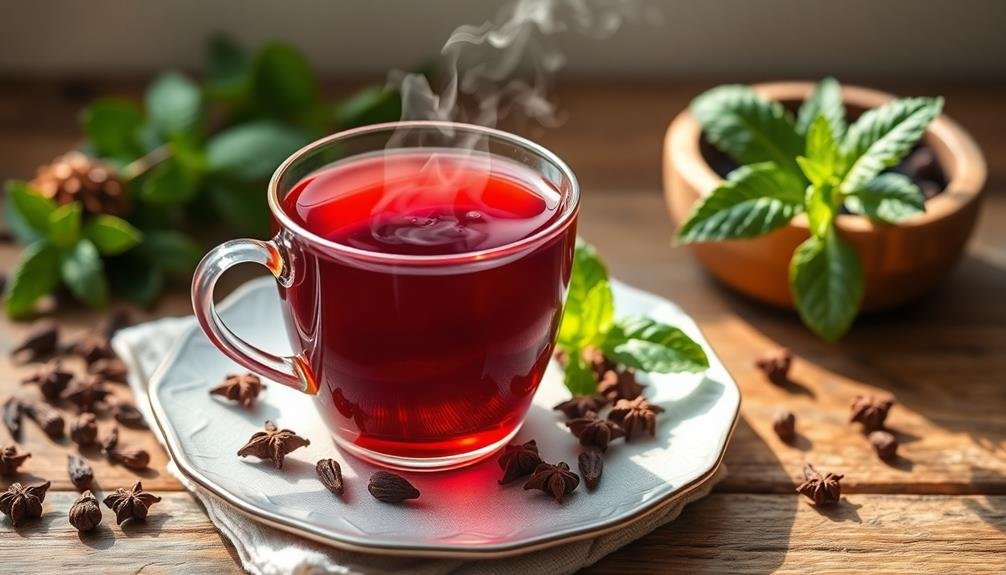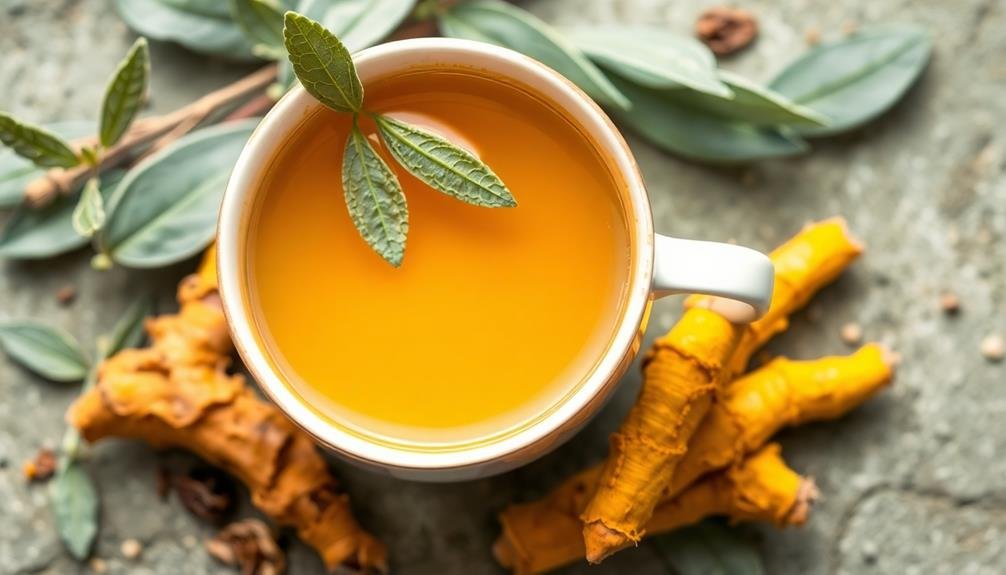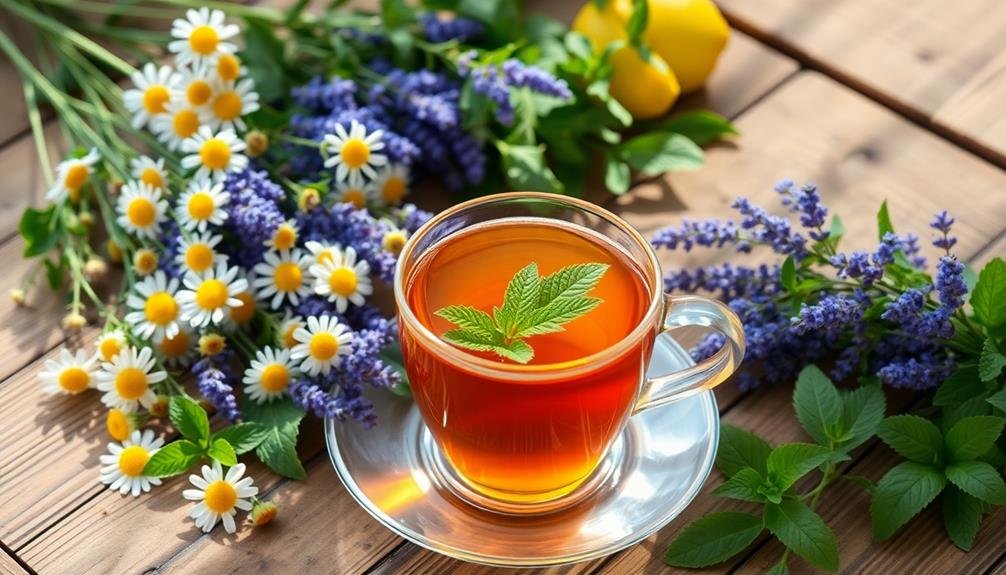If you're looking for caffeine-free herbal teas to ease headaches, you've got great options! Try the Peppermint and Ginger Blend for muscle relaxation, or the Chamomile and Lavender Fusion to calm your mind. The Lemon Balm and Honey Mix promotes relaxation, while Hibiscus and Cinnamon Delight offer a rich taste with health benefits. Rooibos and Clove Combination is packed with antioxidants, and Fennel and Licorice Tea is perfect for digestive support. Nettle and Rosemary, Sage and Turmeric, and Valerian Root with Passionflower are all excellent choices too. Curious about which blend fits your taste best? There's more to explore ahead!
Peppermint and Ginger Blend

If you're looking for a soothing herbal tea to ease your headache, a peppermint and ginger blend might just be the perfect solution. This combination works wonders by leveraging the natural properties of both herbs. Peppermint has menthol, which can help relax muscles and improve blood circulation, while ginger is known for its anti-inflammatory benefits. Together, they create a powerful duo against headache discomfort.
To brew your tea, start by steeping fresh peppermint leaves and grated ginger in hot water for about 10 minutes. You can adjust the amounts to suit your taste. If you're short on time, pre-packaged tea bags are also available, making this remedy quick and convenient.
Drinking this herbal tea not only soothes your headache but also provides a revitalizing taste. You'll appreciate how it can invigorate your senses while alleviating tension.
Plus, it's caffeine-free, allowing you to sip it any time of the day without worrying about jitters or disrupted sleep.
Chamomile and Lavender Fusion
After enjoying the invigorating benefits of peppermint and ginger, you might want to explore another calming option: a chamomile and lavender fusion. This soothing blend combines the relaxing properties of chamomile with the gentle floral notes of lavender, creating a delightful tea that can help ease headache tension.
Chamomile is well-known for its calming effects, which can help reduce anxiety and promote better sleep. When paired with lavender, renowned for its ability to ease stress and improve mood, this combination becomes a powerful ally against headaches. The aroma of lavender alone can provide a sense of tranquility, making it perfect for unwinding after a long day.
To prepare your chamomile and lavender fusion, steep a teaspoon of dried chamomile flowers and a teaspoon of dried lavender buds in hot water for about five to seven minutes. Strain the tea and enjoy it warm, perhaps with a drizzle of honey for added sweetness.
This blend not only tastes great but also offers a natural remedy for tension headaches. So, the next time you feel a headache creeping in, brew a cup of this calming fusion and let it work its magic.
Lemon Balm and Honey Mix

A delightful blend of lemon balm and honey can be your go-to remedy for alleviating headaches. Lemon balm, known for its calming properties, helps soothe tension while honey adds a touch of sweetness and additional health benefits. When you combine these two, you create a comforting drink that not only tastes great but also helps ease your discomfort.
Here's a quick overview of the benefits of this blend:
| Ingredient | Benefit |
|---|---|
| Lemon Balm | Reduces anxiety and promotes relaxation |
| Honey | Provides natural sweetness and boosts energy |
| Warm Water | Aids in hydration and helps soothe headaches |
| Chamomile (optional) | Enhances relaxation and sleep quality |
| Ginger (optional) | Reduces inflammation and nausea |
To prepare, steep lemon balm leaves in hot water for about 5-10 minutes, then stir in a teaspoon of honey. You'll find this warm infusion not only helps to ease your headache but also lifts your spirits. Next time you feel a headache coming on, reach for this delightful blend and enjoy its soothing effects.
Hibiscus and Cinnamon Delight
Moving from the calming embrace of lemon balm and honey, the Hibiscus and Cinnamon Delight offers a vibrant twist for headache relief. This delightful blend combines the tartness of hibiscus with the warm, spicy notes of cinnamon, creating a rejuvenating and flavorful experience that can ease tension and lift your spirits.
Hibiscus is known for its ability to lower blood pressure and promote circulation, which can be beneficial when headaches stem from tension or stress. Its rich antioxidants help combat inflammation, providing an additional layer of relief.
On the other hand, cinnamon's natural anti-inflammatory properties can soothe discomfort and help relax your body.
To prepare this invigorating tea, steep dried hibiscus flowers and a cinnamon stick in hot water for about 10 minutes. You can add a touch of honey or a slice of lemon for extra flavor, enhancing the overall experience while maximizing the health benefits.
Sip this tea slowly, allowing the warmth to envelop you. Enjoy this delightful blend when you need a pick-me-up and want to chase away that nagging headache, letting the flavors work their magic on your senses.
Rooibos and Clove Combination

There's something comforting about the Rooibos and Clove Combination that makes it a wonderful choice for headache relief. Rooibos, naturally caffeine-free, offers a smooth, sweet flavor, while cloves pack a spicy punch that can invigorate your senses. Together, they create a soothing tea that may help alleviate tension and discomfort.
Here's a quick overview of their benefits:
| Ingredient | Benefits |
|---|---|
| Rooibos | Rich in antioxidants; helps reduce inflammation |
| Clove | Contains eugenol, which may relieve pain and improve circulation |
To prepare this delightful blend, steep one teaspoon of Rooibos leaves with a pinch of ground clove in hot water for about 5-7 minutes. Strain and enjoy it plain, or add a touch of honey for sweetness.
This combination not only warms you up but also may help ease headache symptoms. Sip it slowly, letting the flavors unfold, and feel the tension melt away. The Rooibos and Clove Combination could be your new go-to remedy for those pesky headaches. Give it a try the next time you need some relief!
Thyme and Eucalyptus Brew
After enjoying the soothing Rooibos and Clove Combination, you might want to try the Thyme and Eucalyptus Brew for another layer of relief. This herbal blend combines the calming properties of thyme with the invigorating essence of eucalyptus, creating a powerhouse tea that targets headache symptoms effectively.
Thyme is known for its anti-inflammatory and antispasmodic properties, which can help reduce tension and relieve pain. When you sip this brew, you'll not only enjoy its aromatic flavor but also benefit from its potential to ease muscle tightness that often accompanies headaches.
Eucalyptus, on the other hand, brings an invigorating aroma that can clear your sinuses and promote easier breathing. This can be especially helpful if your headache stems from sinus pressure or congestion. The menthol-like compounds in eucalyptus can also provide a cooling sensation, enhancing your overall comfort.
To prepare, steep fresh thyme leaves and eucalyptus leaves in boiling water for about 10 minutes. Strain and enjoy it warm or chilled, depending on your preference.
This delightful brew isn't just a treat for your senses; it's a practical remedy that can help you find relief from headaches naturally.
Fennel and Licorice Tea

Fennel and licorice tea offers a soothing blend that can help ease headaches with its natural properties.
You'll find that the unique flavors and health benefits make it a worthwhile addition to your herbal tea repertoire.
Let's explore the best brewing tips and techniques to maximize its effectiveness.
Benefits of Fennel Licorice
If you've ever sought relief from a headache, fennel and licorice tea might just be the soothing remedy you need. This delightful blend offers numerous benefits that can help ease your discomfort and promote overall well-being.
- Anti-inflammatory Properties: Both fennel and licorice have anti-inflammatory effects that can reduce headache triggers and alleviate tension.
- Digestive Aid: Fennel is known for its ability to support digestion. If your headache stems from digestive issues, this tea can help soothe your stomach and ease discomfort.
- Natural Sweetness: Licorice adds a naturally sweet flavor to your tea without the need for added sugar. This makes for a pleasant drinking experience while avoiding potential blood sugar spikes.
- Stress Relief: Licorice root has adaptogenic properties that may help your body manage stress more effectively. Reducing stress can be a key factor in headache prevention.
Incorporating fennel and licorice tea into your routine can provide not just relief from headaches but also a comforting moment of self-care.
Brewing Tips and Techniques
When you want to brew a comforting cup of fennel and licorice tea, starting with the right ingredients is crucial. Choose high-quality fennel seeds and licorice root to guarantee the best flavor and health benefits. You'll need about a teaspoon of fennel seeds and a teaspoon of dried licorice root for each cup of tea.
Begin by boiling water in a kettle. Once it reaches a rolling boil, remove it from the heat and let it cool for about 30 seconds. This slight cooling helps preserve the delicate flavors of the herbs.
Add the fennel seeds and licorice root to a teapot or infuser. Pour the hot water over the herbs and cover it to trap the steam, which enhances the infusion.
Let it steep for 5 to 10 minutes, depending on how strong you like your tea. If you prefer a sweeter taste, you can add a touch of honey or agave syrup after brewing.
Nettle and Rosemary Infusion
Nestled in the world of herbal remedies, the combination of nettle and rosemary offers a revitalizing infusion that can help alleviate headache symptoms. Nettle is known for its anti-inflammatory properties, while rosemary stimulates circulation, making this blend particularly effective.
To make the most of your nettle and rosemary infusion, consider these tips:
- Choose Quality Ingredients: Use fresh or dried nettle and rosemary from a trusted source. Organic options are often best to avoid pesticides.
- Steep Properly: Steep the herbs in boiling water for about 10 minutes. This allows the beneficial compounds to fully infuse into the water.
- Add Flavor: A squeeze of lemon or a drizzle of honey can enhance the taste, making your tea more enjoyable while still reaping the health benefits.
- Stay Hydrated: Remember, staying hydrated is key. Enjoy your infusion alongside plenty of water throughout the day for ideal relief.
This nettle and rosemary infusion not only tastes great but also provides a natural way to help ease headache discomfort. Enjoy this soothing blend whenever you need a little extra support!
Sage and Turmeric Blend

Savoring a cup of sage and turmeric blend can provide a powerful remedy for headaches. This delightful herbal tea combines two potent ingredients known for their anti-inflammatory properties.
Sage, with its earthy flavor, not only soothes your mind but also aids in reducing tension that often accompanies headaches. Turmeric, on the other hand, brings a warm, slightly bitter note, and its active compound, curcumin, is celebrated for its ability to combat inflammation and pain.
To prepare this blend, steep a teaspoon of dried sage leaves and a half teaspoon of ground turmeric in hot water for about 10 minutes. Strain the mixture, and if you like, add honey or lemon to enhance the taste. Drinking this tea can help relax your muscles and reduce the intensity of your headache.
Additionally, both sage and turmeric have antioxidant properties that support overall health, making this tea not just a remedy but a beneficial addition to your daily routine.
As you sip your sage and turmeric blend, you'll find relief while nurturing your body with nature's best ingredients. Give it a try next time you feel a headache coming on!
Valerian Root and Passionflower Mix
If you're looking for a soothing blend to ease headaches, consider the combination of valerian root and passionflower.
Valerian root offers calming benefits, while passionflower enhances relaxation, making them a powerful duo.
Let's explore how to brew this mix effectively for maximum relief.
Benefits of Valerian Root
Valerian root, often combined with passionflower, offers several benefits for those seeking relief from headaches. This powerful herb can help you tackle the discomfort in a natural way. Here are some key advantages of valerian root:
- Promotes Relaxation: Valerian root is known for its calming effects, helping to ease tension and stress that can contribute to headache pain.
- Improves Sleep Quality: If headaches are linked to poor sleep, valerian root may help you enjoy more restful nights. Better sleep can lead to fewer headaches.
- Reduces Anxiety: By alleviating anxiety, valerian root can help lower the chances of stress-induced headaches. You'll feel more balanced and less prone to tension.
- Natural Pain Relief: Valerian root may have mild analgesic properties, which can help reduce the overall perception of pain, including headaches.
Integrating valerian root into your herbal tea routine could be a game-changer for managing headaches.
Whether you're dealing with tension or stress-related pain, this herb could provide the relief you're looking for. So, consider giving it a try!
Passionflower's Relaxation Effects
Combining passionflower with valerian root creates a powerful herbal blend that enhances relaxation and alleviates headache symptoms.
Passionflower is known for its calming properties, making it an excellent choice for reducing anxiety and promoting better sleep. When you feel a headache coming on, the soothing effects of passionflower can help ease tension and stress that often accompany pain.
This herb works by increasing the levels of gamma-aminobutyric acid (GABA) in your brain, which helps to calm your nervous system. As a result, you might find it easier to unwind and let go of the tightness in your head.
When paired with valerian root, which is also known for its sedative effects, the combination becomes even more effective. Together, they create a synergistic effect that promotes deep relaxation and tranquility.
Brewing Tips and Techniques
To brew a soothing valerian root and passionflower mix, you'll often find that timing and temperature play crucial roles in achieving the best flavor and effects. Here are some tips to help you create the perfect cup:
- Measure Your Ingredients: Use about 1 teaspoon of dried valerian root and 1 teaspoon of dried passionflower for a balanced blend. Adjust according to your taste preference.
- Choose the Right Water Temperature: Heat your water to about 200°F (93°C). This temperature helps extract the beneficial compounds without burning the herbs.
- Steep Time Matters: Allow your tea to steep for 10–15 minutes. Longer steeping will intensify the flavors and effects, giving you a more potent brew.
- Strain and Enjoy: Once steeped, strain the herbs and pour your tea into a cup. You might add a touch of honey or lemon if you prefer a sweeter taste.
With these tips, you'll make a comforting valerian root and passionflower mix that not only tastes great but can also help ease your headaches.
Enjoy the calming benefits with each sip!
Frequently Asked Questions
Are These Herbal Teas Safe for Children and Pregnant Women?
When considering herbal teas for children and pregnant women, it's essential to check specific ingredients. Some herbs might not be safe, so consult a healthcare professional to guarantee the blends you choose are appropriate.
How Often Can I Drink These Headache-Busting Teas?
You can enjoy these headache-busting teas daily, but it's wise to listen to your body. If you notice any adverse effects, consider reducing your intake or consulting a healthcare professional for personalized advice.
Can I Combine Different Herbal Tea Blends?
Absolutely, you can combine different herbal tea blends! Experimenting with flavors and benefits can create a unique, enjoyable experience. Just pay attention to how your body reacts, and adjust the combinations as needed. Enjoy exploring!
How Should I Store These Herbal Tea Blends?
You should store your herbal tea blends in a cool, dry place, away from direct sunlight. Use airtight containers to keep them fresh, and label each blend to easily identify your favorites when you're ready to brew.
What Are the Potential Side Effects of These Herbs?
You should be aware that some herbs can cause allergic reactions, digestive issues, or interact with medications. It's important to consult a healthcare professional before trying new herbal remedies to avoid any unwanted side effects.
In Summary
Incorporating these caffeine-free herbal tea blends into your routine can be a soothing way to manage headaches naturally. Whether you prefer the invigorating taste of peppermint or the calming effects of chamomile, there's a blend for everyone. Remember to listen to your body and find what works best for you. Sipping on these delightful mixtures not only helps alleviate discomfort but also offers a comforting ritual that promotes relaxation and wellness. Enjoy your tea journey!





Leave a Reply